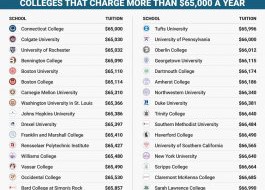
It’s easy to home in on tuition — after all, it’s an obvious, in-your-face expense. But tuition and fees don’t make up the largest portion of the average cost of college attendance.
In the College Board’s most recent Trends in College Pricing, researchers found non-tuition-related expenses at public four-year schools account for 61% of a total $24,610 average cost of attendance.
Here are a few hidden college costs for families to consider before the school year starts.
1. Parking fees

If you plan to commute or keep a vehicle on campus, set aside money for parking ahead of time. Schools typically offer a range of parking packages for students. For example, student parking permits at Boston University go for as low as $266.40 per school year for evening commuters, to $1,905.50 for those who live on campus and need to park overnight.
You may be required to pay a lump sum for parking at the beginning of each semester. Check if your school prices parking passes by location. If they do, research on-campus transit. You may be able to pay for cheaper parking farther from your classes, then hop on campus transit to class. Consider cheaper parking options like city parking lots or curbside options if there are any nearby.
2. Study abroad and other travel
College years are prime time for travel. Whether you’re hitting the beach with friends on spring break or considering an extended study abroad program, you could easily spend thousands of dollars on travel over the course of four years.
Study abroad programs, complete with room, board, instruction, and sometimes internships, can get pricey. For example, Northwestern University estimates a year studying abroad in Brazil to costs about $21,000 for students, while a summer abroad in the University of Georgia’s UGA en Buenos Aires program costs $4,294, plus about $3,000 in tuition and fees.
Often, students finance study abroad trips with financial aid. Just think it through before you take on more debt, especially if you’ve taken on a lot of student debt already. Many school study abroad offices offer scholarships for students. Another good source is Cappex.com, which tracks college scholarships.
3. Food

The average college and university charges about $4,500, or $18.75 per day, for a three-meal-a-day dining contract for a typical 8- or 9-month academic year, according to the Hechinger Report, an independent, nonprofit education news site.
If you want to use the meal plan but the standard campus meal plan is too expensive or wasteful for your budget, you could find savings in a lower-cost plan. Many post-secondary institutions offer lower-cost meal plan packages. Schools may also require first-year students or those living on campus to sign up for a meal plan, but allow upperclassmen and commuters to decide to what extent — if at all — they want to participate.
For example, at New York University, a student can pay $2,800 per semester for an all-access meal plan (28 meals per week) or as little as $1,210 per semester for a so-called “flex” plan (5 meals per week).
4. Books, fees, and supplies
Textbooks and class fees don’t come cheap. The average full-time student at a four-year public institution will spend $1,298 per year on books and supplies, according to the College Board.
Sometimes, fees come as a surprise. In an ongoing study, Wisconsin HOPE Lab researchers tracked the cost experiences of students at four public universities in Wisconsin. At one school, students on the waiting list for a required English course that was full were told to sign up for the online version. Without a heads up, the students were charged an unexpected $250 online course fee.
A student might also need to purchase special equipment or software essential to a course or course of study. Science and technology courses may tack on lab fees, while art students may shell out cash for studio time or class materials.
If you can get hold of a course syllabus early, you should. Don’t only look for what’s required to pass. Check carefully for any fees or payments needed to take the course before you show up. If you can’t get a copy of the syllabus and are unsure, you can usually reach the professor to ask via email.
5. Your family's changing financial picture

You could be surprised by a rise in your cost of attendance if you or your family’s financial picture changes.
The effects of this scenario are demonstrated in the Wisconsin Scholars Longitudinal Study, a six-year-long investigation of how Pell Grant recipients attending public institutions in Wisconsin experienced the price of higher education conducted by the HOPE Lab.
Researchers found the financial burden on students grows over time as tuition rises and families experience financial changes. Twenty percent of students in the study experienced a median $1,215 hike in the Expected Family Contribution — how much of the cost of attendance their household was expected to pay after their first year. When your EFC grows, it means you’re likely to be awarded less financial aid.
Many students, they found, also lost eligibility for the Pell Grant and other aid dependent on Pell eligibility.
6. Dried up scholarships and grants
Additionally, students usually receive the most financial aid for their first year of college, but scholarships and grants may not stick around for all four years. They could be allotted for the first year only, or a student may lose academic or financial eligibility. Many universities use “front loading” to attract freshman to the school. They recruit incoming freshman with grants and scholarships and may not continue to fund grants for continuing students. On average this increases the net price from the first to second year of college by about $1,400.
Contact your school’s financial aid office early on if you expect a change in income to affect your EFC, as you may be able to explain your situation in an appeal. If you receive a scholarship or grant, carefully scrutinize the terms to make sure you know how long the money will last and what you’ll need to do to keep the award.
7. A new laptop

For many courses, having a laptop or access to a personal computer is crucial to success. Be prepared to pay $700 to $1,500 for that success, depending on the specs you need to excel in your major.
Some of the pricing is dependent on the laptop’s operating system. Students can get a Google computer for a couple of hundred dollars or a PC for less than $700, while an Apple Macbook Air starts at about $1,000. Always ask about a student discount. Some retailers like Apple offer discounted education pricing models for students and educators. Others, like Best Buy, periodically send out a newsletter with college student deals. You could save hundreds just by leveraging your student status.
Try using the school’s computers to complete work outside of class if they come with the software you need already loaded. You may also be able to rent laptops, tablets, cameras, and other technology from your school or local retailers. If you need to purchase software, and it can be downloaded on multiple computers, you could share a login with a classmate to share and split the cost.
8. Club and organization fees
Socializing comes at a price in college. Campus organizations often charge membership dues ($10-$25 at the low end), but it can get much more expensive for students looking to enter a sorority or fraternity. UCLA estimates the average annual cost of room, board, and dues to be about $7,650 for sororities and $8,328 for fraternities. That’s before adding in all of the other membership costs like clothing and fees to attend social functions.
While in an organization, there will likely be multiple occasions when you would need to buy merchandise, gifts, or clothing for events. If you’re into sports, for example, you may want to participate in an intramural sports league. You might need to pay a league fee, then purchase equipment and a team uniform.
Overall, keep your budget top of mind when faced with these opportunities. You might think twice about handing over thousands to your new “brothers” if it means skipping meals later on in the semester.
9. Internships

Internships — especially unpaid ones — can get expensive. Internships present a great opportunity for students to connect with others in their selected field and learn on-the-job skills, but they don’t pay much. For a student financing their education alone, an unpaid or low-paying internship could mean a missed opportunity. You could get offered the internship of your dreams with a large company, then have to turn it down if the pay is too little to cover your living costs.
Let’s say you accept an unpaid part-time summer internship offer (in exchange for course credit) from a firm in an expensive city like Los Angeles. It may be nearly impossible to make ends meet without financial assistance from your family or loans. Yes, you could probably cover some costs with another part-time position, or save money by staying in co-living community like Purehouse, but you’ll be scraping by to eat decent food or do anything outside of work.
The most competitive and best-paying internships are quickly filled. Apply to paid internships early on if an unpaid internship is out of the question. Periodically check for paid spring and summer internships with fall semester deadlines. Look for internships close to campus or your family to offset costs. If the internship is in another city, check to see if you have family or friends you can stay with for the time.
10. "Fun"
Social events present great opportunities to connect outside of class with others in your major or cohort. However, being a social butterfly is a quick way to deplete any bank account.
For example, student season tickets for the 2016 Ohio State football season ran students $180 to attend all five Big Ten conference games. To attend an additional two conference games, students would need to purchase a $252 package. That’s before you spend money on food, drinks, and an outfit for the pre-game tailgate.
You only have four to six years to make long-lasting relationships in college that could affect the rest of your life, so it’s understandable to feel pressure to attend parties, hang out at bars, go to dinners, and other activities. However, you could go broke or get into debt if you’re not careful.
Look for free or low-cost events to attend, then be selective about which events and activities are worth it for your budget. Keep an eye on your spending and always ask if you can save money on meals, clothes, or events with a student ID discount. You might get teased for seeming “cheap,” but you could avoid putting these expenses on a credit card.
11. Health insurance and medical costs

If you do not get health coverage through your parents, some schools may require you to sign up for a health plan. For example, New York University automatically enrolls students in its school-sponsored health care plan, but students can waive the plan if they can provide evidence they maintain alternate health insurance coverage that meets the university’s minimum health insurance criteria.
The cost of a basic plan for the spring 2017 semester: $1,654. If you’re an out-of-state student and don’t find alternative insurance coverage in time for classes, you could be stuck paying the bill as “NYU requires that all students registered in degree-granting programs maintain health insurance.”
Shop around to be sure you’re getting the best coverage at the best price possible. That may mean going outside of your school’s designated plan. You might want to consider signing up for coverage in the federal government’s Health Insurance Marketplace or your state’s equivalent insurance marketplace.
12. Housing

Room and board make up about 42% of the total cost of attendance at four-year public institutions, according to the College Board. After tuition, housing is the second-largest expense students will encounter.
For students who choose (or for whom it is required) to live in on-campus housing, room and board might be a non-negotiable expense. The cost to live in a dorm can vary from as low as $5,326 for the school year to more than $18,000 according to U.S. News Short List rankings. Generally speaking, it’s cheaper to live on campus in areas with higher rent, while off-campus housing is cheaper in areas with lower rental costs.
Other on-campus living requirements such as enrollment in the school’s meal plan, a security deposit, and dorm fees can also add up.
Don’t assume the university’s housing cost estimate is correct, as schools use different factors to calculate costs. A 2015 Trulia analysis found “schools often underestimate the cost of off-campus housing, sometimes by thousands of dollars for the school term.” For example, the University of California, Berkeley, estimates a student would spend $7,184 to live off campus, while Trulia’s data showed it would cost $12,375 for two students to share a two-bedroom apartment for nine months.
Tips to save on off-campus housing:
Compare costs to on-campus housing. Depending on where you attend school, a 9- or 12-month off-campus lease plus utilities and internet might actually be more expensive than room and board in a university dorm.
Look for roommates to help ease the burden of utilities and other bills.
Use search engines like Uloop and College Student Apartments to filter through housing options near your school and find even more savings.
13. Furniture and decor
Plan to budget a few hundred bucks for furniture and decor. If you’re lucky, your dorm or apartment might include a few pieces of furniture. Even then, you’ll need bedding, curtains, linens, and other staples. Plan to spend funds on furniture and decorations to make the new space feel like home.
The good news is that any college town where students are constantly moving in and leaving each year are great for the resellers market. Check out Craigslist in your area to save on furniture, or resale sites like AptDeco, Furnishare, or Furnishly. Facebook’s new marketplace feature is a good idea, too.
Pro tip: Consider starting a college registry. Target’s College Registry offers a 15% discount on any items that aren’t purchased. Also, don’t forget your student ID card. Some retailers may offer student discounts.
Read the original article on Magnify Money. Copyright 2017. Follow Magnify Money on Twitter.




